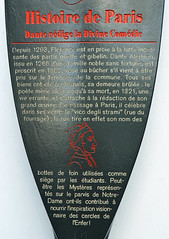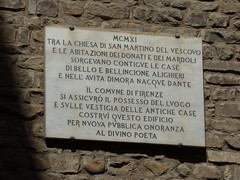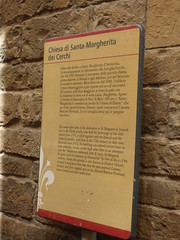

Dante Alighieri
(1265-1321)
man
Died aged c. 56
Wikidata WikipediaDante Alighieri (Italian: [ˈdante aliˈɡjɛːri]; c. 1265 – 14 September 1321), probably baptized Durante di Alighiero degli Alighieri and often referred to as Dante (English: /ˈdɑːnteɪ, ˈdænteɪ, ˈdænti/, US: /ˈdɑːnti/), was an Italian poet, writer and philosopher. His Divine Comedy, originally called Comedìa (modern Italian: Commedia) and later christened Divina by Giovanni Boccaccio, is widely considered one of the most important poems of the Middle Ages and the greatest literary work in the Italian language. Dante is known for establishing the use of the vernacular in literature at a time when most poetry was written in Latin, which was accessible only to the most educated readers. His De vulgari eloquentia (On Eloquence in the Vernacular) was one of the first scholarly defenses of the vernacular. His use of the Florentine dialect for works such as The New Life (1295) and Divine Comedy helped establish the modern-day standardized Italian language. His work set a precedent that important Italian writers such as Petrarch and Boccaccio would later follow. Dante was instrumental in establishing the literature of Italy. His depictions of Hell, Purgatory and Heaven provided inspiration for the larger body of Western art and literature. He influenced English writers such as Geoffrey Chaucer, John Milton and Alfred Tennyson, among many others. In addition, the first use of the interlocking three-line rhyme scheme, or the terza rima, is attributed to him. He is described as the "father" of the Italian language, and in Italy he is often referred to as il Sommo Poeta ("the Supreme Poet"). Dante, Petrarch, and Boccaccio are also called the tre corone ("three crowns") of Italian literature.
DbPedia
Commemorated on 3 plaques
Dante rédige la Divine Comédie Depuis 1293, Florence est en proie à lutte incessante des partis guelfe et gibelin. Dante Alighieri, issu en 1265 d'une famille noble sans fortune, est proscrit en 1302, voué au bûcher s'il vient à être pris sur le territoire de la commune. Tous ses biens ont été confisqués, sa demeure brûlée; le poète mène alors jusqu'à sa mort, en 1321, une vie errante, et s'attache à la rédaction de son grand oeuvre. De passage à Paris, il célèbre dans ses écrits le "vico degli strami" (rue du fourrage); la rue tire en effet son nom des bottes de foin utilisées comme siège par les étudiants. Peut-être les Mystères représentés sur le parvis de Notre-Dame ont-ils contribué à nourrir l'inspiration visionnaire des cercles de l'Enfer!
English translation: Dante has been writing the Divine Comedy Since 1293, Florence has been in constant struggle with the guelf and gibelin parties. Dante Alighieri, born in 1265 of a noble family without fortune, was banned in 1302, dedicated to the stake if it comes to be taken on the territory of the commune. All his property was confiscated, his house burned, and the poet then led a wandering life until his death in 1321, and devoted himself to the writing of his great work. While in Paris, he celebrates in his writings the “vico degli strami” (rue du fourrage); the street derives its name from the hay boots used as the seat by the students. Perhaps the Mysteries represented on the parvis of Our Lady have helped to nourish the visionary inspiration of the circles of Hell! [AWS Translate]
10 rue Legrange, Paris, France where they was
MCMXI Tra la Chiesa di San Martino del vescovo e le abitazioni dei donati e dei mardoli sorgevano contigue le case di bello e Bellincione Alighieri e nell avita dimora nacque Dante Il Comune di Firenze Si assicuro il possesso del luogo e sulle vestigia delle antiche case costrui questo edificio per nuova pubblica onoranza al divino poeta
English translation: MCMXI Between the Church of San Martino del Bishop and the dwellings of donors and mardoli stood adjoining the houses of beautiful and Bellincione Alighieri and in the life dwelling Dante was born The Municipality of Florence Si assicuro the possession of the place and the remains of the ancient houses built this building for a new public honor to the divine poet [AWS Translate]
Museo Casa di Dante - Via Santa Margherita, Florence, Italy where they lived near
Chiesa di Santa Margherita dei Cerchi Oltre alla dedica a Santa Margherita d'Antiochia, la denominazione fa riferimento alla famiglia Cerchi, che dal 1353 detenne il patronato della piccola chiesa, prima insieme ai Donati e agli Adimari, poi nel Seicento in maniera esclusiva. Ricordato sin dal 1032, l'edificio e stato rimaneggiato a piu riprese nei secoli successivi. All'internom sull'altar maggiore si trova la pala con la Madonna in trono con le sante Lucia, Margherita, Agnese e Caterina d'Alessandria di Neri di Bicci (XV sec.). Santa Margherita e considerata anche la "chiesa di Dante", che qui forse sposo Gemma Donati e pote conoscervi l'amata Beatrice Portinari, la cui famiglia aveva qui le proprie sepolture.
English translation: Church of Santa Margherita dei Cerchi In addition to the dedication to Santa Margherita d'Antioch, the name refers to the Cerchi family, who since 1353 held the patronage of the small church, first together with the Donati and Adimari, then in the seventeenth century in an exclusive way. Recreated since 1032, the building has been repainted over and over the following ages. Inside the main altar there is the altarpiece with Our Lady on throne with Saints Lucia, Margherita, Agnes and Catherine of Alexandria of Neri di Bicci (15th century). Santa Margherita is also considered the “Church of Dante”, who here perhaps marry Gemma Donati and was able to meet the beloved Beatrice Portinari, whose family had their burials here. [AWS Translate]
Chiesa di Dante - Via Santa Margherita, Florence, Italy where they was married at


